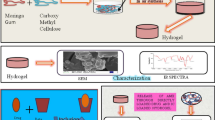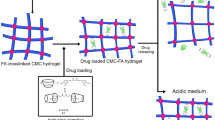Abstract
Microencapsulation is an attractive method in the production of controlled release and targeted delivery systems and is widely used to increase the bioavailability of antimicrobial molecules. Chitosan (CS) is commonly used as the wall material of microcapsules and demonstrates antibacterial and antifungal features. In this study, curcumin (CUR) and CS as bioactive substances were loaded in polycaprolactone (PCL) by microencapsulation method. The electrospinning method was used for the production of microencapsulated biomaterials as polymer composite fibers. SEM analysis of polymer composites was performed and the fiber size of PCL-CUR/CS composite fiber was measured as 248.71 ± 98 nm. The bioactive release kinetics correlation coefficient (R2) value and mathematical model of the polymer compounds were analyzed as PCL-CS/CUR; 0.98, Zero order, PCL-CUR; 0.93, Korsmeyer-Peppas and PCL-CS; 0.95 Higuchi, respectively. Antifungal activity experiments were performed on the obtained polymer composite fibers and the minimum inhibitory concentrations of PCL-CS, PCL-CUR, and PCL-CS/CUR composite fibers against Aspergillus niger were determined as >5000 ppm, 750 ppm, 2500 ppm, and 2500 ppm, respectively. The minimum inhibitory concentrations of PCL-CS, PCL-CUR, and PCL-CS/CUR against Penicillium digitatum were >5000 ppm, 250 ppm, 1666 ppm, and 1666 ppm, respectively. These results revealed that PCL/-CS/CUR polymer composite fibers may be used as both antifungal and antibacterial bioactive material in tissue engineering applications.
Graphical Abstract

Highlights
-
CUR and CS loaded into PCL via microencapsulation.
-
PCL-CS/CUR composite fibers were fabricated.
-
Composites had great antifungal-antibacterial activities with MIC against A. niger/P. digitatum.
-
CUR exhibits Zero-order, Korsmeyer–Peppas, and Higuchi release kinetics in fibers.





Similar content being viewed by others
Data availability
The author confirm that the data supporting the findings of this study are available within the article. Raw data that support the findings of this study are available from the corresponding author upon reasonable request.
References
Asghari F, Samiei M, Adibkia K et al. (2017) Biodegradable and biocompatible polymers for tissue engineering application: a review. Artif Cells Nanomed Biotechnol 45:185–192
Flores-Rojas GG, Gómez-Lazaro B, López-Saucedo F et al. (2023) Electrospun scaffolds for tissue engineering: a review. Macromol 3:524–553. https://doi.org/10.3390/macromol3030031
Bhushan S, Singh S, Maiti TK et al. (2022) Scaffold fabrication techniques of biomaterials for bone tissue engineering: a critical review. Bioengineering 9. https://doi.org/10.3390/bioengineering9120728
Zhao P, Gu H, Mi H et al. (2018) Fabrication of scaffolds in tissue engineering: a review. Front Mech Eng 13:107–119
Yupanqui Mieles J, Vyas C, Aslan E et al. (2022) Honey: an advanced antimicrobial and wound healing biomaterial for tissue engineering applications. Pharmaceutics 14. https://doi.org/10.3390/pharmaceutics14081663
Mittal H, Ray SS, Kaith BS et al. (2018) Recent progress in the structural modification of chitosan for applications in diversified biomedical fields. Eur Polym J 109:402–434
Farooq M, Ihsan J, MK Mohamed R et al. (2022) Highly biocompatible formulations based on Arabic gum Nano composite hydrogels: fabrication, characterization, and biological investigation. Int J Biol Macromol 209:59–69. https://doi.org/10.1016/j.ijbiomac.2022.03.162
Wang Y, Sun H (2021) Polymeric nanomaterials for efficient delivery of antimicrobial agents. Pharmaceutics 13. https://doi.org/10.3390/pharmaceutics13122108
Gobi R, Ravichandiran P, Babu RS, Yoo DJ (2021) Biopolymer and synthetic polymer-based nanocomposites in wound dressing applications: a review. Polymers 13. https://doi.org/10.3390/polym13121962
Abou Neel EA, Pickup DM, Valappil SP et al. (2009) Bioactive functional materials: a perspective on phosphate-based glasses. J Mater Chem 19:690–701. https://doi.org/10.1039/b810675d
Sharma S, Sudhakara P, Singh J et al. (2021) Critical review of biodegradable and bioactive polymer composites for bone tissue engineering and drug delivery applications. Polymers 13. https://doi.org/10.3390/polym13162623
Farag MM (2023) Recent trends on biomaterials for tissue regeneration applications: review. J Mater Sci 58:527–558
Mecwan M, Falcone N, Najafabadi AH, Khorsandi D (2023) Antioxidant activity. In: ACS symposium series 71–80. https://doi.org/10.1021/bk-2023-1438.ch005
Parın FN, Parın U (2022) Spirulina biomass-loaded thermoplastic polyurethane/polycaprolacton (TPU/PCL) nanofibrous mats: fabrication, characterization, and antibacterial activity as potential wound healing. ChemistrySelect 7. https://doi.org/10.1002/slct.202104148
Janmohammadi M, Nourbakhsh MS (2019) Electrospun polycaprolactone scaffolds for tissue engineering: a review. Int J Polym Mater Polym Biomater 68:527–539
Backes EH, Harb SV, Beatrice CAG et al. (2022) Polycaprolactone usage in additive manufacturing strategies for tissue engineering applications: a review. J Biomed Mater Res Part B Appl Biomater 110:1479–1503
Pei W (2021) Application of polycaprolactone-based biopolymer scaffolds in tissue engineering. Chin J Tissue Eng Res 25:5506–5510
Siddiqui N, Asawa S, Birru B et al. (2018) PCL-based composite scaffold matrices for tissue engineering applications. Mol Biotechnol 60:506–532
Chaudhari AA, Vig K, Baganizi DR et al. (2016) Future prospects for scaffolding methods and biomaterials in skin tissue engineering: a review. Int J Mol Sci 17:1–32. https://doi.org/10.3390/ijms17121974
Abedalwafa M, Wang F, Wang L, Li C (2013) Biodegradable PCL for tissue engineering applications: a review. Rev Adv Mater Sci 34:123–140
Ramanujam R, Sundaram B, Janarthanan G et al. (2018) Biodegradable polycaprolactone nanoparticles based drug delivery systems: a short review. Biosci Biotechnol Res Asia 15:679–685. https://doi.org/10.13005/bbra/2676
Sachan R, Warkar SG, Purwar R (2023) An overview on synthesis, properties and applications of polycaprolactone copolymers, blends & composites. Polym Technol Mater 62:327–358
Mohamed RM, Yusoh K (2015) A review on the recent research of polycaprolactone (PCL). Adv Mater Res 1134:249–255. https://doi.org/10.4028/www.scientific.net/AMR.1134.249
Huq T, Khan A, Brown D et al. (2022) Sources, production and commercial applications of fungal chitosan: a review. J Bioresour Bioprod 7:85–98
Kou SG, Peters LM, Mucalo MR (2021) Chitosan: a review of sources and preparation methods. Int J Biol Macromol 169:85–94
Parhi R (2020) Drug delivery applications of chitin and chitosan: a review. Environ Chem Lett 18:577–594
Karaca AE, Özel C, Özarslan AC, Yücel S (2022) The simultaneous extraction of cellulose fiber and crystal biogenic silica from the same rice husk and evaluation in cellulose-based composite bioplastic films. Polym Compos 43:6838–6853. https://doi.org/10.1002/pc.26729
Ciftci F (2023) Release kinetics modelling and in vivo-vitro, shelf-life study of resveratrol added composite transdermal scaffolds. Int J Biol Macromol 235:123769. https://doi.org/10.1016/J.IJBIOMAC.2023.123769
Hamedi H, Moradi S, Hudson SM et al. (2022) Chitosan based bioadhesives for biomedical applications: a review. Carbohydr Polym 282. https://doi.org/10.1016/j.carbpol.2022.119100
Seidi F, Khodadadi Yazdi M, Jouyandeh M et al. (2021) Chitosan-based blends for biomedical applications. Int J Biol Macromol 183:1818–1850
Ke CL, Deng FS, Chuang CY, Lin CH (2021) Antimicrobial actions and applications of chitosan. Polymers 13. https://doi.org/10.3390/polym13060904
Miot-Sertier C, Paulin M, Dutilh L, et al. (2022) Assessment of chitosan antimicrobial effect on wine microbes. Int J Food Microbiol 381. https://doi.org/10.1016/j.ijfoodmicro.2022.109907
Sabir SM, Zeb A, Mahmood M et al. (2021) Phytochemical analysis and biological activities of ethanolic extract of curcuma longa rhizome. Braz J Biol 81:737–740. https://doi.org/10.1590/1519-6984.230628
Rachtanapun P, Klunklin W, Jantrawut P, et al. (2021) Characterization of chitosan film incorporated with curcumin extract. Polymers 13. https://doi.org/10.3390/polym13060963
Zhongfa L, Chiu M, Wang J et al. (2012) Enhancement of curcumin oral absorption and pharmacokinetics of curcuminoids and curcumin metabolites in mice. Cancer Chemother Pharm 69:679–689. https://doi.org/10.1007/s00280-011-1749-y
Sohn SI, Priya A, Balasubramaniam B, et al. (2021) Biomedical applications and bioavailability of curcumin—an updated overview. Pharmaceutics 13. https://doi.org/10.3390/pharmaceutics13122102
Chen Y, Lu Y, Lee RJ, Xiang G (2020) Nano encapsulated curcumin: and its potential for biomedical applications. Int J Nanomed 15:3099–3120
Sharifi-Rad J, Rayess YE, Rizk AA et al. (2020) Turmeric and its major compound curcumin on health: bioactive effects and safety profiles for food, pharmaceutical, biotechnological and medicinal applications. Front Pharmacol 11. https://doi.org/10.3389/fphar.2020.01021
Jiang T, Ghosh R, Charcosset C (2021) Extraction, purification and applications of curcumin from plant materials—a comprehensive review. Trends Food Sci Technol 112:419–430
Sideek SA, El-Nassan HB, Fares AR et al. (2023) Different curcumin-loaded delivery systems for wound healing applications: a comprehensive review. Pharmaceutics 15. https://doi.org/10.3390/pharmaceutics15010038
Fahimirad S, Abtahi H, Satei P, et al. (2021) Wound healing performance of PCL/chitosan based electrospun nanofiber electrosprayed with curcumin loaded chitosan nanoparticles. Carbohydr Polym 259. https://doi.org/10.1016/j.carbpol.2021.117640
Shafiee A, Moradi L, Lim M, Brown J (2021) Coronavirus disease 2019: a tissue engineering and regenerative medicine perspective. Stem Cells Transl Med 10:27–38. https://doi.org/10.1002/sctm.20-0197
Zhou Y, Li S, Tan W et al. (2023) Design, synthesis, and preparation of ultrasound-responsive curcumin-loaded chitosan nanocarriers. Russ J Gen Chem 93:108–115. https://doi.org/10.1134/S1070363223010152
Enumo A, Argenta DF, Bazzo GC et al. (2020) Development of curcumin-loaded chitosan/pluronic membranes for wound healing applications. Int J Biol Macromol 163:167–179. https://doi.org/10.1016/j.ijbiomac.2020.06.253
Parın FN, Ullah A, Yeşilyurt A, et al. (2022) Development of PVA–psyllium husk meshes via emulsion electrospinning: preparation, characterization, and antibacterial activity. Polymers 14. https://doi.org/10.3390/polym14071490
Zahiri M, Khanmohammadi M, Goodarzi A et al. (2020) Encapsulation of curcumin loaded chitosan nanoparticle within poly (ε-caprolactone) and gelatin fiber mat for wound healing and layered dermal reconstitution. Int J Biol Macromol 153:1241–1250. https://doi.org/10.1016/j.ijbiomac.2019.10.255
Liu X, Xu Y, Liao W, et al. (2023) Preparation and characterization of chitosan/bacterial cellulose composite biodegradable films combined with curcumin and its application on preservation of strawberries. Food Packag Shelf Life 35. https://doi.org/10.1016/j.fpsl.2022.101006
Golchin A, Hosseinzadeh S, Staji M et al. (2019) Biological behavior of the curcumin incorporated chitosan/poly(vinyl alcohol) nanofibers for biomedical applications. J Cell Biochem 120:15410–15421. https://doi.org/10.1002/jcb.28808
Mohamadi PS, Hivechi A, Bahrami H et al. (2022) Antibacterial and biological properties of coconut oil loaded poly(ε-caprolactone)/gelatin electrospun membranes. J Ind Text 51:906S–930S. https://doi.org/10.1177/1528083721991595
Liu K, Huang RL, Zha XQ, et al. (2020) Encapsulation and sustained release of curcumin by a composite hydrogel of lotus root amylopectin and chitosan. Carbohydr Polym 232. https://doi.org/10.1016/j.carbpol.2019.115810
Lee BN, Hong SJ, Yu MH, et al. (2022) Enhancement of storage stability and masking effect of curcumin by turmeric extract-loaded nanoemulsion and water-soluble chitosan coating. Pharmaceutics 14. https://doi.org/10.3390/pharmaceutics14081547
Ng SW, Selvarajah GT, Hussein MZ, et al. (2020) In vitro evaluation of curcumin-encapsulated chitosan nanoparticles against feline infectious peritonitis virus and pharmacokinetics study in cats. Biomed Res Int https://doi.org/10.1155/2020/3012198
Li J, Hwang IC, Chen X, Park HJ (2016) Effects of chitosan coating on curcumin loaded nano-emulsion: study on stability and in vitro digestibility. Food Hydrocoll 60:138–147. https://doi.org/10.1016/j.foodhyd.2016.03.016
Ciftci F, Duygulu N, Yilmazer Y et al. (2023) Antibacterial and cellular behavior of PLA-based bacitracin and zataria multiflora nanofibers produced by electrospinning method. Int J Polym Mater Polym Biomater 72:319–334. https://doi.org/10.1080/00914037.2021.2008391
Targhi AA, Moammeri A, Jamshidifar E, et al. (2021) Synergistic effect of curcumin-Cu and curcumin-Ag nanoparticle loaded niosome: enhanced antibacterial and anti-biofilm activities. Bioorg Chem 115. https://doi.org/10.1016/j.bioorg.2021.105116
Kubasad S, Tamase AS, Kadam KK (2022) Evaluation of preliminary anti-microbial efficacy of curcumin and chitosan nanoparticles with and without photoactivation against—an invitro study. IP Indian J Conserv Endod 7:120–124. https://doi.org/10.18231/j.ijce.2022.026
Erarslan A, Karakas CY, Bozkurt F, Sagdic O (2023) Enhanced antifungal activity of electrosprayed poly (vinyl alcohol)/chitosan nanospheres loaded with sage essential oil on the viability of aspergillus niger and botrytis cinerea. ChemistrySelect 8. https://doi.org/10.1002/slct.202300296
Fatma Nur P, Pınar T, Uğur P, et al. (2021) Fabrication of polyamide 6/honey/boric acid mats by electrohydrodynamic processes for wound healing applications. Mater Today Commun 29. https://doi.org/10.1016/j.mtcomm.2021.102921
Çobanoglu B, Parin FN, Yildirim K (2021) Production and characterization of n-halamine based polyvinyl chloride (pvc) nanowebs. Tekst Konfeksiyon 31:147–155. https://doi.org/10.32710/tekstilvekonfeksiyon.717601
Acknowledgements
The authors would like to thank Fatih Sultan Mehmet Vakif University Technology Transfer Office and Biomedical Department Biomaterials BİORGİNE Laboratory for supporting this study.
Author information
Authors and Affiliations
Contributions
FÇ: conceptualization, methodology, investigation, formal analysis, writing—original draft, visualization. ACÖ: conceptualization, methodology, formal analysis, writing—review and editing.
Corresponding author
Ethics declarations
Conflict of interest
The authors declare no competing interests.
Additional information
Publisher’s note Springer Nature remains neutral with regard to jurisdictional claims in published maps and institutional affiliations.
Rights and permissions
Springer Nature or its licensor (e.g. a society or other partner) holds exclusive rights to this article under a publishing agreement with the author(s) or other rightsholder(s); author self-archiving of the accepted manuscript version of this article is solely governed by the terms of such publishing agreement and applicable law.
About this article
Cite this article
Ciftci, F., Özarslan, A.C. Fabrication of polycaprolactone-chitosan/curcumin polymer composite fibers and evaluation of their in vitro release kinetic behavior and antibacterial-antifungal activity. J Sol-Gel Sci Technol 109, 192–203 (2024). https://doi.org/10.1007/s10971-023-06264-x
Received:
Accepted:
Published:
Issue Date:
DOI: https://doi.org/10.1007/s10971-023-06264-x




